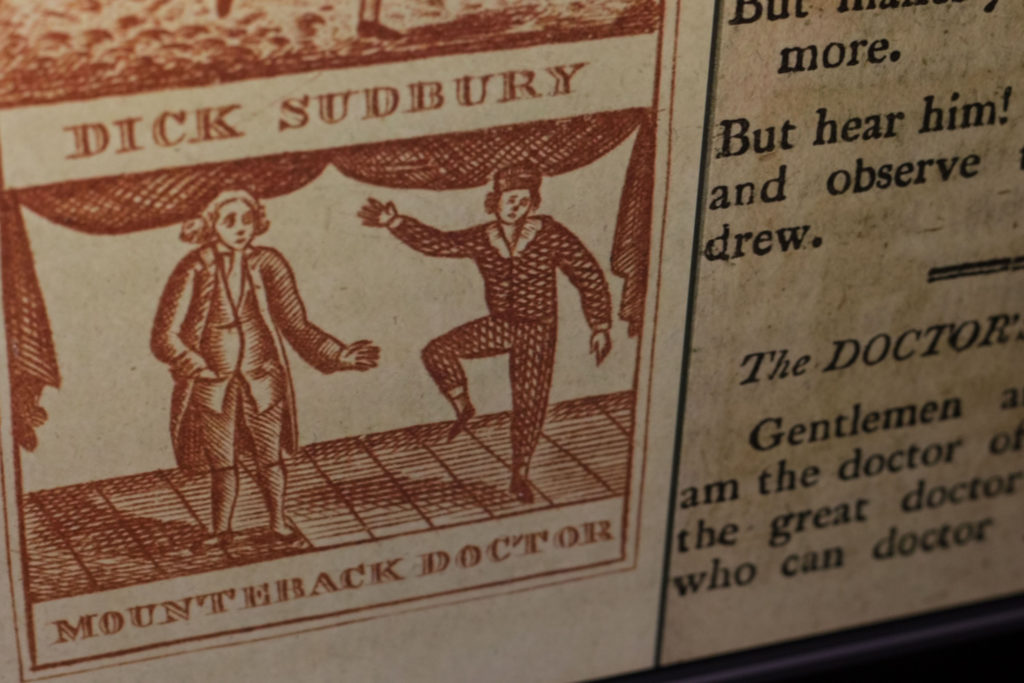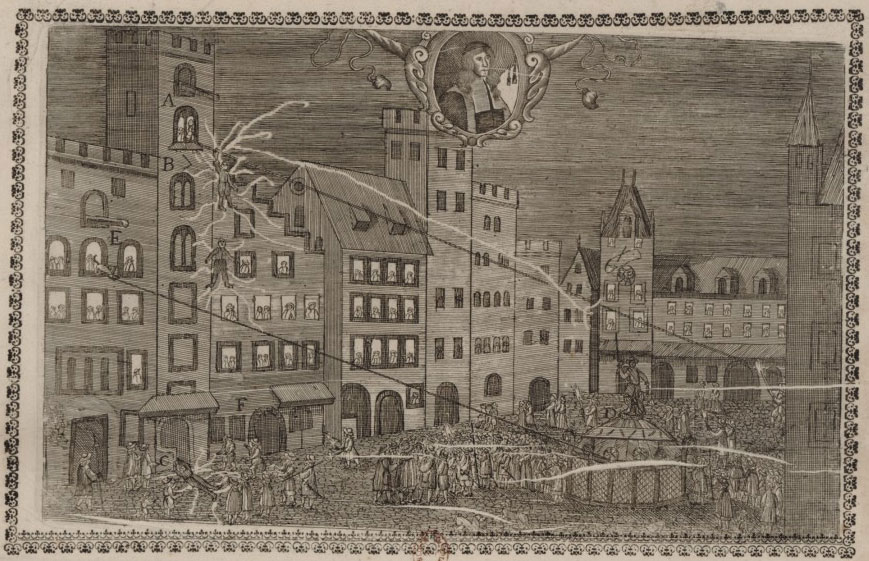Have a drink with: Your Local Mountebank
Healthcare! Fireworks! Toads!
Ask him about: What ails you
We’re all getting a lot of weird healthcare advice lately, and I admit that it’s hard to stomach the idea that our country, which vanquished polio and smallpox with scientific elbow grease, is entertaining the medical expertise of a presidential toady who thinks endometriosis happens when you have a demon boyfriend. But history has long tolerated – and even encouraged – the side hustle of non-traditional medical practitioners, and we continue to use some of their lingo even today.
For centuries of recorded history, the mountebank was a famous and recurring figure in daily life in cities and towns. “Mountebank” is the term for an itinerant medical man who plied his trade with a mix of entertainment, health-care marketing, soft-shoe and snake-oil entrepreneurship. A miniature moral pamphlet from England in 1820 (entitled Fun Upon Fun, because telling kids to avoid the roulette table is fun, isn’t it, kids?) narrates a typical country fair and announces: “Hey day! who comes here? Oh, this is the Mountebank. He talks of curing every sore, but makes you twice as many more.”
(In Seussian fashion, the Mountebank character is said to announce: “Gentlemen and Ladies, I am the doctor of all doctors, the great doctor of doctors, who can doctor you all.” Take notes, Fauci.)
The job description for a mountebank involved far more than medical skill – being a journeyman, he had to draw a crowd and establish himself as a remarkable person with remarkable skills and remarkable wares to sell. The ideal candidate was something of a cross between a tent-revival minister, a magician, an infomercial host and a zookeeper. Some might engage a comedian or performing fool to draw a crowd in with a light and lively performance (the word “zany” originally was a noun referring to a mountebank’s clown), and a young boy or two to help work the crowd. Sometimes gimmicks, tricks or exotic animals beckoned passers-by. Sometimes the medical man himself would do double duty: sure, the “flying surgeon” Charles Bernoin was renowned for his skill treating a range of unpleasant complaints from ulcers and cataracts to cancers, but let’s not forget that he tended to draw patients into his waiting room, such as it was, by strapping fireworks to his person and rocketing into crowds headfirst on makeshift zip-lines. What could go wrong?
(A lot, as it turned out: when one of the gunpowder rockets on Bernoin’s wooden wingspan failed to ignite at a German event in 1673, throwing his thrust off-balance, he did not so much “descend dramatically into the plaza” as “bury himself in the pavement.”)
Charisma was required to sell healthcare, as often was sleight of hand. Tooth-pullers might insinuate fake teeth made of ox bone into the mouths of planted volunteers, to make their extraction services seem especially pain-free; sometimes self-inflicted “wounds” were miraculously healed by tinctures and oils on offer. A very popular sales pitch involved the mountebank – or, more often, his most junior assistant – ingesting poison or eating entire animals in order to hawk the antidote. According to scholar M. A. Katritzky, “German quacksalvers customarily exhibited live animals of a humbler order, typically poisonous spiders, toads, and lizards, but often heightened the spectacular effect by making a show of ingesting one or another of them, in addition to poisons such as arsenic or mercury, before ‘curing’ themselves with their patent antidotes.” Toads were especially popular and unlucky subjects at these fairground clinics, as most people understood them to be poisonous, and the mountebank’s young “toad eater” would make a show of gulping one down whole, falling down in pain and then drinking the elixir of the moment in order to leap up hale and hearty.
From this bizarre sideshow-pharma marketing technique we get the term “toady,” referring to someone with an unhealthy level of fawning devotion to their boss or an unwise cause.
Don’t eat toads.
Fun Facts:
This isn’t purely ancient history, mind you: a Kansas statute from 1923 states that “It shall be unlawful for any person to exhibit in a public way within the state of Kansas, any sort of exhibition that consists of eating or pretending to eat of snakes, lizards, scorpions, centipedes, tarantulas or other reptiles.” (Since repealed, don’t worry. Eat up.)
Etymology all over the place, here: the word “charlatan” comes from this wandering medical tradition, too. Our word derives from “ciarlatano,” a portmanteau of two Italian words: “ciarlare” (chatter) and “cerretano” (someone from the town of Cerreto, whose occupants were known for “wandering about dressed as pilgrims, collecting alms under false pretenses”). Historian David Gentilcore notes that while charlatans were treated with disdain and skepticism by establishment physicians, some were in fact decently educated, and they were generally tolerated so long as they did not overstep their social limits (or fail to pay required licensing fees).
Toads, by the way, ARE poisonous. (In a very mountebank-appropriate story, medical research has documented the unfortunate case of a man who died in 2003 after ingesting alleged aphrodisiac pills that turned out to involve toad venom; let me repeat, we generally have not gotten wiser as a human species, just substitute “mountebank” for “internet.”) Considering the mountebank’s repertoire and general approach to life and business, it’s very possible that no live toads were harmed in the course of this particular exercise, and that staff members just had slimy pockets, or toad-shaped biscuits, or something. But then again, there are accounts that suggest people actually watched toadies eat toads, and that maybe there was either an understanding that a small toad and a big stomachache was all part of a day’s wages. Either way, again: DON’T EAT TOADS.
Additional Reading:
The Harangues, or speeches, of several celebrated quack-doctors in town and country (1750)
M. A. Katritzky, “Marketing medicine: the image of the early modern mountebank,” Renaissance Studies, June 2001, Vol. 15, No. 2
David Gentilcore, “‘Charlatans, Mountebanks and Other Similar People’: The Regulation and Role of Itinerant Practitioners in Early Modern Italy,” Social History, Vol. 20, No. 3 (Oct. 1995)

